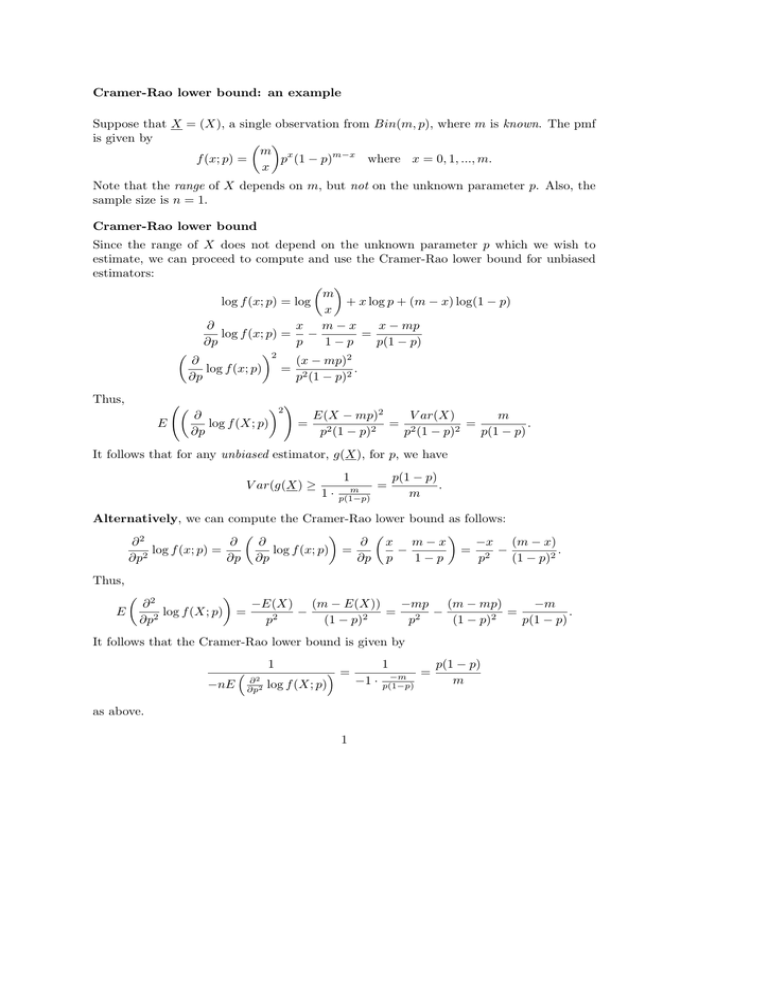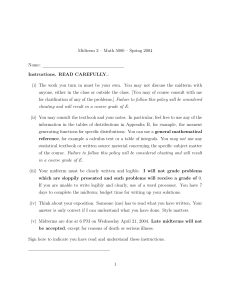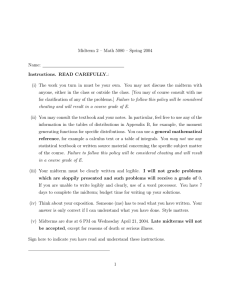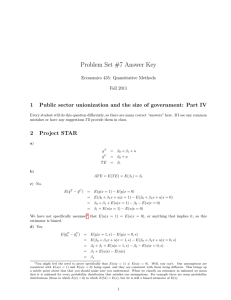Cramer-Rao lower bound: an example Suppose that X = (X), a
advertisement

Cramer-Rao lower bound: an example Suppose that X = (X), a single observation from Bin(m, p), where m is known. The pmf is given by m x f (x; p) = p (1 − p)m−x where x = 0, 1, ..., m. x Note that the range of X depends on m, but not on the unknown parameter p. Also, the sample size is n = 1. Cramer-Rao lower bound Since the range of X does not depend on the unknown parameter p which we wish to estimate, we can proceed to compute and use the Cramer-Rao lower bound for unbiased estimators: m log f (x; p) = log + x log p + (m − x) log(1 − p) x ∂ x m−x x − mp log f (x; p) = − = ∂p p 1−p p(1 − p) 2 ∂ (x − mp)2 log f (x; p) = 2 . ∂p p (1 − p)2 Thus, E 2 ! ∂ E(X − mp)2 V ar(X) m log f (X; p) = 2 = 2 = . 2 2 ∂p p (1 − p) p (1 − p) p(1 − p) It follows that for any unbiased estimator, g(X), for p, we have V ar(g(X) ≥ 1 1· m p(1−p) = p(1 − p) . m Alternatively, we can compute the Cramer-Rao lower bound as follows: ∂2 ∂ ∂ ∂ x m−x −x (m − x) log f (x; p) = log f (x; p) = − = 2 − . 2 ∂p ∂p ∂p ∂p p 1−p p (1 − p)2 Thus, E ∂2 −E(X) (m − E(X)) −mp (m − mp) −m log f (X; p) = − = − = . 2 2 2 2 2 ∂p p (1 − p) p (1 − p) p(1 − p) It follows that the Cramer-Rao lower bound is given by 1 −nE ∂2 ∂p2 = −1 · log f (X; p) as above. 1 1 −m p(1−p) = p(1 − p) m Handout #1 Comparing estimators Consider the estimator g1 (X) = X m. E(g1 (X)) = E(X) mp = =p m m so g1 (X) is an unbiased estimator of p. Is it the most efficient unbiased estimator for p? To answer this question, we compute the variance of g1 and compare it to the Cramer-Rao lower bound which we calculated above. V ar(g1 (X)) = V ar( X V ar(X) mp(1 − p) p(1 − p) )= = = . 2 2 m m m m Since V ar(g1 ) equals the Cramer-Rao lower bound, we can conclude that g1 (X) is the most efficient unbiased estimator for p. Now consider the estimator g2 (X) = E(g2 (X)) = X+1 m+2 . E(X) + 1 mp + 1 = 6= p (except when p = 1/2). m+2 m+2 So g2 is a biased estimator with bias(g2 ) = E(g2 (X)) − p = mp + 1 1 − 2p −p= . m+2 m+2 To compare the performance of g2 with the performance of g1 , we must first compute the mean square error of g2 : V ar(g2 (X)) = V ar( V ar(X + 1) mp(1 − p) X +1 )= = . 2 m+2 (m + 2) (m + 2)2 Thus, M SE(g2 ) = V ar(g2 )+(bias(g2 ))2 = 1 mp(1 − p) (1 − 2p)2 + = (1+(m−4)p−(m−4)p2 ). 2 2 (m + 2) (m + 2) (m + 2)2 We can compare the (relative) efficiency of g1 and g2 by comparing the graphs of M SE(g1 ) (which is just the variance of g1 ) and M SE(g2 ) as functions of p. Exercise: Fix m = 10 and sketch the graphs of M SE(g1 ) and M SE(g2 ) as functions of p. Also, determine the values of p for which g2 is more efficient than g1 . 2







